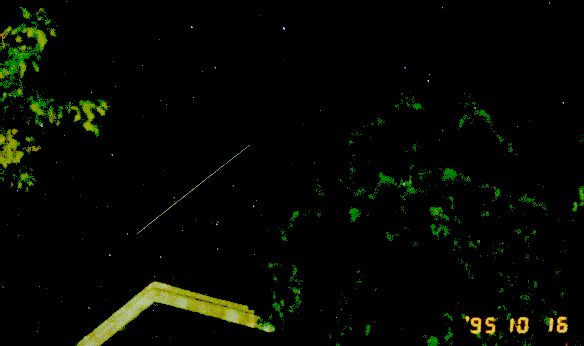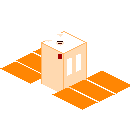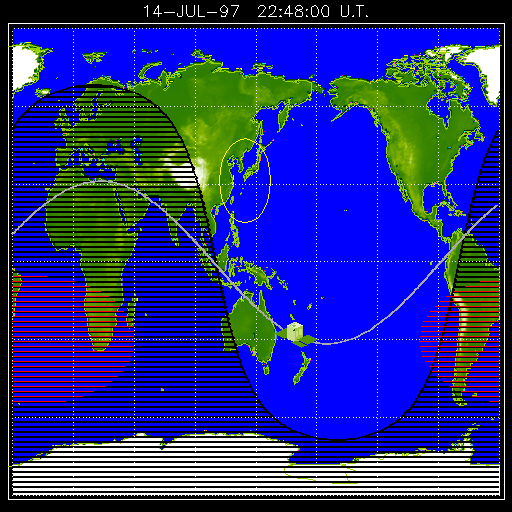Overview
Students studying physics use Internet resources to determine the orbitalperiod of satellites. Using Newton's Universal Law of Gravity, studentsthen calculate satellite orbital velocities and altitudes. A printableversion of this activity is found here.
Learning Outcomes
By completing this activity, the learner will:
![]()
Anticipatory Set
 Howoften
have you seen slowly satellites passing overhead in the night sky? If
you know when to look, you can see the Space Shutte, the Hubble SpaceTelescope,
or nearly a hundred communication or weather satellites. From Earth,
satellites look like dim stars, usually moving slowly fromnorth to south
(they look different from jet airplanes because airplaneshave flashing
lights). There are software programsavailable
for purchase that tell you exactly which satellites are visiblefrom
your house at different times. There are also two WWW sites(NCand
GA) that can make predictions.More
information is available from the Visual Satellite Observers Organization(VSO)and
by picking nearby locations at SatPass.
Howoften
have you seen slowly satellites passing overhead in the night sky? If
you know when to look, you can see the Space Shutte, the Hubble SpaceTelescope,
or nearly a hundred communication or weather satellites. From Earth,
satellites look like dim stars, usually moving slowly fromnorth to south
(they look different from jet airplanes because airplaneshave flashing
lights). There are software programsavailable
for purchase that tell you exactly which satellites are visiblefrom
your house at different times. There are also two WWW sites(NCand
GA) that can make predictions.More
information is available from the Visual Satellite Observers Organization(VSO)and
by picking nearby locations at SatPass.
![]()
Exploration
Below is a recent map showing the position of the Yohkoh Satellite. A
joint Japanense and US project, Yohkoh monitors the x-ray output fromour
Sun. On the WWW, you can view the currentposition
of the Yohkoh Satellite and the mostrecent
image of our Sun. Everytime that you check this map orclick RELOAD,
you'll get the latest image.
 Considerthe
following questions.
Considerthe
following questions.
![]()
Concept Introduction
Part I - Determine the orbital period of Yohkoh
 Thereare
some really important things to notice on the map.
Thereare
some really important things to notice on the map.
By watching the satellite over several hours, you can determine howlong
it takes for Yohkoh to go around Earth once (if you don't wantto watch
the satellite every 15 minutes or so - there is an archivemovie
available). The current Yohkoh position mapis found at
http://www.lmsal.com/cgi-bin/yopos. Click
the image and hit RELOAD so see the updatedposition.
Determine the length of time for one orbit of the Yohkoh spacecraft.
![]()
Part II - Determine the orbital velocity of Yohkoh
The velocity can be determined once the orbital period is known (seePart
I above). Velocity is defined as the distance an objecttravels
divided by time. For a circular path, the distance traveledis the
circumference, 2pr. Where
"r"is
the distance the satellite is from the center of Earth. Determinethe
velocity, v ; be sure you carefully specify your units.
|
orbital velocity v= (2p r) / t where "t"is orbital period |
distance from center of Earth r= Eradius + Hheightwhere "Eradius"= 3960 X 103 m |
Determine the orbital velocity of the Yohkoh spacecraft.
![]()
Part III - Determine the orbiting altitude of Yohkoh
By combining Newton's Universal Law of Gravity with the centripetalforce
that causes an object to move in a circle, we can solve the equationfor
"r". Then, thealtitude
is determined by subtracting the radius of Earth, Eradius,from
the total distance of the satellite from Earth's center, "r".
|
Newton's Universal Law of Gravity |
Central Force Causing an Object to Move ina Circle |
Altitude, Hheight |
| Fgravity=Gm Earthmsatellite/
r2
equation 1 |
Fcircl = msatellite v2/
r
equation 2 |
Hheight = r-
Eradius
equation 3 |
| G = 6.672 X 10-11 Nm2/kg2 mEarth = 5.98 X 1024 kg r = distance of satellite from centerof Earth |
velocity, v = 2pr/
t
period, t = time to orbit Earth once (from Part I) |
Eradius = 3960 X 103 m |
First, set Fgravity = Fcircle (i.e.,set equation 1 equal to equation2). Second, solve the equation algebraically for the distancethat the satellite orbits from the center of Earth, r. Finally, determine the altitude, Hheightfrom equation 3. Determine the altitude of the Yohkoh spacecraft.
![]()
Concept Debriefing
![]()
Concept Application
Create a report on one of the NASA satellites listed below. Thereport should have three distinct parts.
 Usethe
Internet to determine all of the background information you need todescribe
the: (1) history, (2) purpose, and (3) orbital characteristicsof the satellite.
Use the same procedure as above to calculate theorbital characteristics;
determine the orbital period, velocity, and altitude. Be sure that
your report shows the details of how you made all of yourcalculations.
Usethe
Internet to determine all of the background information you need todescribe
the: (1) history, (2) purpose, and (3) orbital characteristicsof the satellite.
Use the same procedure as above to calculate theorbital characteristics;
determine the orbital period, velocity, and altitude. Be sure that
your report shows the details of how you made all of yourcalculations.
Select One of these NASA Satellites (orchoose a different one approved by your instructor)
a Space Shuttle (if in orbit) current location(map1or
map 2 or map3)
and more information.
b Mir Space Station ... current location (map1or
map2)
c Hubble Space Telescope... current location (map1or
map2)
d Cosmic Background Explorer... current location (map1or
map2)
e NOAA Weather Satellites... current location map1
![]()
Lesson designed by the YPOPTeam
For questions about this lesson, please contactTim
Slater